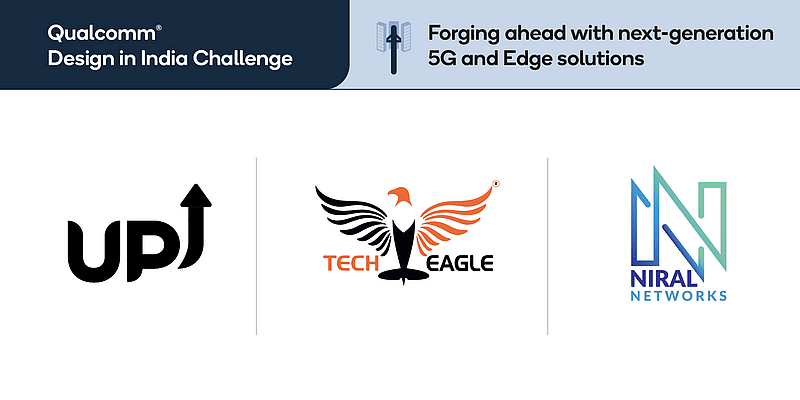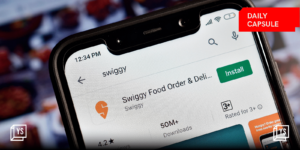5G and edge computing are on the rise. The culmination helps in creating opportunities for new products, platforms, and experiences in every industry. According to a report by Gartner, 75 percent of all the data generated will be collected, analysed, and acted on at the edge by the end of 2025. This in turn will serve as a huge opportunity for Indian organisations to have a resilient long-term business strategy, leveraging the benefits that edge computing has to offer.
Edge computing brings computation and data storage closer to where people, places, and things create data. Besides, the exponential growth in the number of smart devices, the need for faster processing, and the increased pressure on networks is the driving force behind the edge computing market.
The seventh edition of the Qualcomm Design in India Challenge (QDIC) includes 12 startups designed by India and supported by Qualcomm. This cohort of QDIC includes three startups driving innovation in the area of 5G and edge computing. Here’s a quick look at how QDIC enables these startups to step up their innovation game and drive impact.
React Labs
“Back in 2021, we suddenly realised that even though phones and TV have come a long way, the other home appliances with which we interact all day, have been static in technology since the 1960s. Particularly if we discuss Indian kitchens, the appliances in them have not advanced with time. Thus, we started “Upliances” to address this, and level up people’s homes and lifestyles. We are aimed at moving appliances to the future with connected and smart technology,” explains Mahek Mody, Co-founder, and CEO, React Labs.
Founded in 2021, React Labs is known for creating its flagship concept Upliance, which comes with an 8’ touchscreen showcasing a variety of recipes, from which users can choose by following the simplified instructions to assemble and prep ingredients. “Our first product is a smart cooking assistant ‘delishUp’ which comes with a jar that chops, stirs, and cooks all the meals with minimal human intervention. An integrated weighing scale takes out the guesswork and improves portion control. Currently, the device has empowered more than 300 homes across India, reducing their reliance on ordering in and allowing them to cook anything at a whim,” adds Mahek.
Mahek also mentions Qualcomm’s platform to make the delishUp more powerful and responsive. “Qualcomm’s platform is very powerful. To truly understand and implement it, we had to level up our game. Unraveling the stack’s potential has allowed us to discover and design for more delights and features. During the course of the program, we have been able to transform our cooking experience and be able to rapidly iterate on our connected features and data pipeline,” he adds.
DelishUp has also evolved rapidly in the past few months and is on the cusp of changing the way Indians address their daily cooking needs. “We have tested the product in more than 300 real kitchens across India. During the tests, we have been able to iterate on existing features, resolve bugs and build new functionality. Our recipes have also gone through a transformative journey, and we aim to continue to build more features like grocery integration, and meal planning along with more recipes to meet the diversity of our target audience. We want to be able to have a direct and lasting impact on young Indian homes and the quality of their lives,” adds Mahek.
TechEagle Innovations
Gurugram-based aviation and aerospace component manufacturing company TechEagle Innovations is creating drone logistics airlines for the medical, parcel, and other essential items. Vikram Singh, CEO and Founder, TechEagle Innovations explains, “We are an AI, 5G-enabled drone delivery hub and spoke network to transform the supply chain and last-mile logistics deliveries agnostic to industries and sectors like e-commerce, maritime, hyperlocal and healthcare, etc. All our drones are autonomous and managed through our proprietary cloud-based fleet management software system and an Unmanned Aircraft System Traffic Management (UTM) software to operate them safely with other aircraft systems in the same airspace.”
Vikram remembers how the motivation behind TechEagle’s foundation was his observation of his surroundings. “My childhood had devastating memories of losing my close relatives due to snake bites and inaccessibility to proper healthcare. Thus, I was keen to eradicate such problems from society,” he adds.
Also, while preparing for a competition to be held in the United States, where participants from around the globe would design, develop and demonstrate drones that could precisely drop a certain payload to a designated location, Vikram and his team conceptualised the idea of a drone that can transport documents.
“Besides thinking about how drones can transport parcels and documents from Kanpur to Lucknow, I also envisioned them transporting critical medicines to remote corners of the country. That’s when I realised the need to solve this larger problem of logistics for healthcare, and parcels,” he explains.
TechEagle was born in July 2015 at the hostel garage of IIT Kanpur.
Vikram specifically talks about Qualcomm’s development kit and the support from Qualcomm’s team in building a 5G-based command and control system over the cloud for controlling drones virtually from anywhere in the world.
“Using the technology we shall be able to scale the operations across different parts of the country and the world and control the drone and drone fleet using the cloud-based system. Besides, we are working with the Qualcomm® Snapdragon™ X55 5G Modem and integrating it with our hardware for implementing various features in the in-house developed product,” he adds.
Currently, Vikram is most excited about their next product which is currently in the prototyping stage. Vertiplane X25 can carry a payload of 25 kg and cover a maximum distance of 300 km in one flight. Besides, there are also projects with different state governments, government bodies, and different corporations.
Niral Networks
Bengaluru-based Niral Networks is known for delivering curated, open, and disaggregated private 5G and Edge Infrastructure as a Service (5GaaS), optimising emerging technologies like THE drone, robotics, IoT, and AR/VR in mining, oil & gas, power, railway, port, and manufacturing units.
Expanding on the idea that led to the formation of Niral Networks, Abhijit Chaudhary, the founder and CEO adds, “I started with a consulting firm in a similar domain, and we got a contract to work with a Middle East Asian operator to build a product. That was in 4G and even its four years now, it’s still supporting almost 2 million customers in the Middle East. That triggered us to upgrade ourselves from doing consulting work with operators in the telecom domain and networking domain, and shift to building a product company, in this domain, out of India. Thus, the entire idea was to build a 5G product out of India.”
Abhijit feels that they are trying to create a significant impact in society by enabling the 5G network. “Our kind of solution can be used to create a private network within the village. Similarly, the same private network can be used for differences in border sites, where there is no connectivity. Even WiFi cannot give you proper connectivity across 10 square kilometers, for both indoor and outdoor. Thus, for a high bandwidth connectivity scaling with mobility, we are trying to provide private files,” he explains.
Abhijit explains that end devices need the help of Qualcomm’s technology to enable the private 5G network that they have built. “Qualcomm makes the chipset which are used to connect all these end devices like drones, mobile phones, or even robots. For instance, they are equipped with 5G connectivity by connecting their chipset to the 5G network. With this support by Qualcomm, we are enabling multiple such devices to get connected, starting from video surveillance, then video gaming, paving the way to integrate all these applications to our private 5G network, which would ultimately lead to industry 4.0 or digitalisation of the industries,” he adds.
Abhijit highlights how RG500Q based on the Qualcomm® Snapdragon™ X55 5G Modem kit is used by Niral Networks while they are demonstrating the use cases to the end customer, and while explaining the strength of the 5G network. “You can connect your laptop to this Qualcomm RG500 Q kit over an Ethernet, post which it can be used for effortless video streaming. For example, if a person is in a mining site with a laptop, and he doesn’t have a 5G sim, he can opt for the device, connect to the 5G theme, and then live stream,” he explains.
Envisioning the future days, Abhijit feels private 5G network would play a very critical role while enabling the operation technique, and technology connectivity within the campus, be it an IIT campus or a manufacturing, an oil and gas, or a power grid, to enable that unit connectivity.





![Read more about the article [Funding alert] Logistics automation startup Unbox Robotics raises $7M in Series A from 3one4 Capital, Sixth Sense Ventures, others](https://blog.digitalsevaa.com/wp-content/uploads/2021/12/CopyofImageTaggingNewBrandingEditorialTeamMaster6-1640154593611-300x150.jpg)




